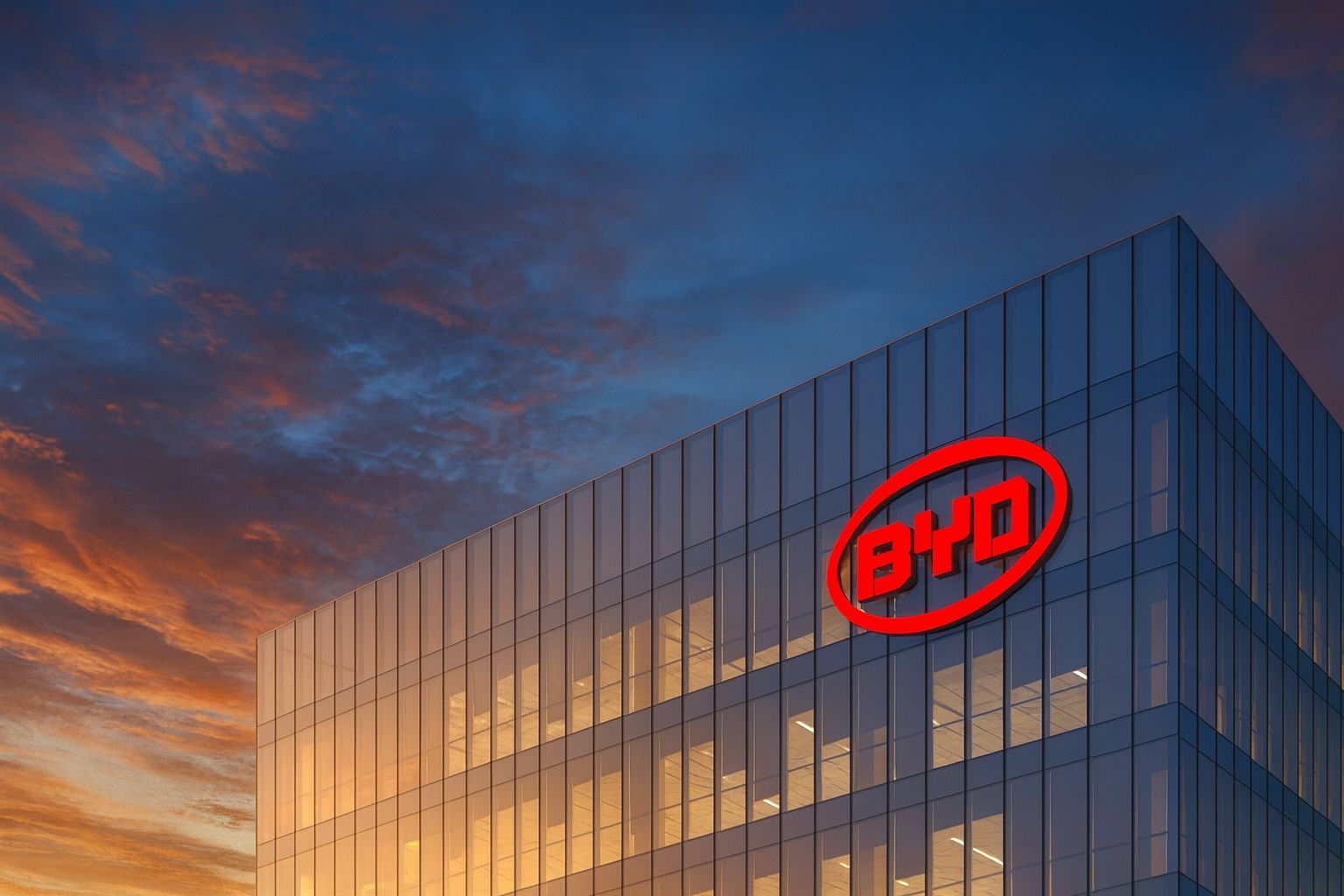- Record European sales: BYD’s electric cars are exploding in Europe. The UK became BYD’s biggest overseas market (11,271 cars sold in Sept. 2025, up nearly 10× YoY [1]) and Germany saw a record 3,255 registrations that month (vs. only 140 a year earlier) [2]. Ace Analyst Stephen Dyer (AlixPartners) warns only ~15 of 129 Chinese EV brands will survive by 2030 [3], and BYD – benefiting from subsidies and economies of scale – leads the pack.
- Stock rollercoaster: After Warren Buffett’s Berkshire sold its remaining BYD stake, the stock briefly plunged. Still, as of Oct 13 BYD’s Hong Kong H-share trades around HK$106.3 (about +19.6% YTD) [4]. Analysts are bullish: TipRanks shows 7/9 recommend “buy” with an average target ~HK$204. (Even BYD’s Frankfurt-listed shares dipped to ~€11.33 on recent trade worries [5].)
- Chinese EV shakeout: China’s fierce EV price war is finally winding down, and regulators have banned deep discounts. Consequently BYD recorded its first quarterly sales decline since 2020 in Q3 2025 [6]. Industry experts (and BYD execs) emphasize that future growth will hinge on exports: BYD’s Stella Li notes global sales outside China will drive its growth in 2025 [7]. Forecasts remain strong – S&P Global projects BYD’s European sales to reach ~186,000 in 2025 (up from 83k in 2024) and nearly 400k by 2029 [8]. Deutsche Bank and Morningstar estimate BYD will sell ~4.7–4.8 million cars in 2025 [9] (versus BYD’s own target of 4.6M).
- Tech peers under pressure: Tesla rival Xiaomi is also making EV headlines (240,000 preorders in 18 hours for its new SUV [10]), but its stock has slid ~6% on recent selloff (to €5.50, a 6-month low) [11]. Alibaba – once seen as China’s AI crown jewel – fell nearly 10% last week amid US-China trade fears [12] (though still ~+35% YTD). German defense leader Rheinmetall dipped ~1.2% as China’s new rare-earth export curbs (especially on germanium) threaten its margins [13] [14].
BYD’s European Sales Explosion
Industry reports confirm that China’s biggest EV maker is tearing up European sales charts. Deutsche Welle’s Welt notes “the world’s largest Chinese e-car maker is celebrating ever greater success in Europe. In Britain sales have recently exploded… and in Germany the figures are also rising significantly” [15]. Indeed, BYD’s September figures were eye-popping: UK registrations jumped from 1,150 (Sept 2024) to 11,271 [16], propelling the UK to BYD’s largest market outside China. In Germany, BYD sold 3,255 vehicles in Sept 2025, a new high (vs. just 140 a year ago) [17]. BYD’s SUV sedans and plug-in hybrids (like the Dolphin/Surf) have undercut rivals on price, helping the company triple its European sales in 2025 so far [18] [19].
BYD is rapidly localizing its production to meet demand. It is already building plants in Hungary (production to start end-2025) and Turkey (planned 2026 start) [20], and even eyeing a third European plant – reportedly in Germany – to avoid EU tariffs on Chinese EVs [21]. (A Reuters source says S&P expects BYD’s Europe sales to more than double to ~186,000 this year, and near 400,000 by 2029 [22].) BYD is also pushing other markets: a “mega-plant” in Bahia, Brazil (initially 150k/year, up to 600k later) opened recently [23], targeting Latin America.
Nevertheless, China’s home market has cooled. After months of aggressive discounts (themselves spurred by prior oversupply), Beijing intervened to outlaw “irrational” price cuts. Finanzen.net reports that once-BYD sales growth is now stalling: “In Q3 2025 BYD posted its first year-on-year sales decline since 2020,” as the subsidy-fueled frenzy slows [24]. Local rivals are starting to nibble away at BYD’s share. As analyst Stephen Dyer (AlixPartners) warns, China had 129 EV/plugg-in brands and “only ~15…will be financially viable by 2030” [25]. (In fact, outside BYD and Li Auto, almost no Chinese EV maker is yet profitable [26].) Kevin Net of Financière de l’Echiquier cautions that while BYD’s long-term story is strong, its aggressive “market share gain by pricing” could pressure margins short-term [27].
Market Reaction & Stock Outlook
The volatile China/global landscape has been painfully visible in BYD’s stock. On Oct 10, concerns over US-China trade flared: China announced stricter rare-earth export controls and President Trump threatened new tariffs. That day BYD’s Frankfurt listing fell -5.7% to €11.33 [28] (a 6-month low), wiping out much of its mid-year gains [29]. By Oct 13, the Hong Kong H-share was around HK$106.30 (about HK$106) [30] – down ~1.7% from its recent peak but still +19.6% year-to-date [31]. (BYD’s Frankfurt ADR/U.S. ADRs have similar moves.)
Fundamentally, analysts remain generally positive. TipRanks shows 7 of 9 analysts with “buy” ratings on BYD [32], and the average price target is a lofty HK$203.93 (implying ~100% upside) [33]. Even Morgan Stanley and Nomura recently reaffirmed BUY calls with targets well above current levels (see marketscreener.com). S&P Global Mobility projects BYD’s overseas sales could reach 1 million in 2025 [34], far above the company’s own targets. BYD’s scale is enormous: in H1 2025 its revenue ($51.9B) already exceeded Tesla’s ($41.8B) [35]. Tesla still enjoys much higher margins, but with Tesla’s U.S. sales flat, BYD is catching up as a growth play [36] [37].
At the same time, earnings have dipped: BYD’s Q2 profit plunged ~30% [38], partly due to heavy discounting. Buffett’s exit shook sentiment: Berkshire Hathaway’s full sell-off (as confirmed Sept. 2025) sent BYD down sharply before it stabilized [39]. Deutsche Börse data shows BYD’s market cap peaked in May and has since fallen. But importantly, BYD still boasts double-digit revenue growth in 2025 and leadership positions in batteries and hybrids. As BYD’s Stella Li told Reuters, “BYD’s growth in 2025 will be driven by sales outside China” [40], a strategy likely to sustain the company’s long-term prospects.
Related Tech Players & Risks
The China tech/EV stock selloff wasn’t limited to BYD. Xiaomi’s newly-crowned EV buzz has tempered after a fatal crash and profit warnings, but its car ambitions are clear. Its second EV, the YU7 SUV, flaunts an 835km range and is expected to undercut Tesla on price [41]. Xiaomi drew ~240,000 pre-orders in 18 hours for the YU7 [42] – even Ford’s CEO Jim Farley hailed Xiaomi as “a company to watch” in EVs [43]. (Xiaomi’s first EV sedan outsold Tesla’s Model 3 last year [44].) Nevertheless, Xiaomi’s stock plunged ~6.1% on Oct 10 to €5.50 [45], its lowest since April, as market sentiment cooled.
Alibaba, China’s cloud/AI behemoth, also took a hit. Riding high earlier for its AI prospects, Alibaba fell nearly -9.7% on Oct 10 [46] due to fears of a renewed trade war. While it’s still far above its 2024 lows, analysts note that in a full-blown tariff battle its growth could slow sharply.
Even non-tech German firms felt it. Rheinmetall (DAX defense) warned that China’s new restrictions on “rare earth” materials (especially Germanium) will squeeze margins [47]. The stock slid ~1.2% after these reports [48], though still near record highs. (Supply disruptions remain largely theoretical for now.)
Forecast and Analysis
What’s next? In the short term, global trade tensions and China’s regulatory shift will keep BYD (and peers) on edge. Analysts expect some consolidation: weaker EV startups will likely fold, leaving leaders like BYD, NIO and Li Auto to dominate. BYD’s own move into plug-in hybrids – poised to outsell full EVs in Europe [49] – gives it a hedge if pure-EV demand slows.
Longer-term, BYD looks positioned for continued growth. It boasts massive production capabilities (half a million vehicles/year coming from Turkey+Hungary plants [50], plus the new Brazil plant). The company’s vertical integration (batteries, motors, chips) and affordable pricing have created a moat. If China’s EV subsidy program shifts from discounts to charging infrastructure, BYD may adapt better than smaller rivals.
On the stock side, BYD’s valuation is still below Tesla’s on a P/E basis [51], suggesting upside if profits recover. A turnaround in Chinese auto demand or further global expansion could trigger a rebound. However, investors should be wary that BYD’s blistering growth phase may moderate; as Kevin Net observes, aggressive price-slashing can “weigh on margins” in the near term [52]. In sum, BYD remains a must-watch EV titan: its fundamentals (sales volumes, international expansion, tech edge) are strong, but regulatory pushback and macro risks inject volatility. Weighing the bullish analyst forecasts [53] [54] against recent headwinds, a balanced forecast might see BYD stock regain ground into 2026 (if global demand holds), potentially approaching those HK$200 targets – but with possible choppy trading ahead.
Sources: Market data and expert commentary from Finanzen.net/Finanzen.at and Reuters (Oct 2025) [55] [56]; Chinese industry reports (TS2.tech, Welt, electrive) [57] [58] [59]; UK/Germany sales data [60] [61]; recent market analyses (NTG24, TS2) [62] [63]. All figures quoted are as of mid-Oct 2025.
References
1. eletric-vehicles.com, 2. eletric-vehicles.com, 3. ts2.tech, 4. www.finanzen.net, 5. www.ntg24.de, 6. www.finanzen.net, 7. www.reuters.com, 8. www.reuters.com, 9. ts2.tech, 10. ts2.tech, 11. www.ntg24.de, 12. www.ntg24.de, 13. www.ntg24.de, 14. www.ntg24.de, 15. www.welt.de, 16. eletric-vehicles.com, 17. eletric-vehicles.com, 18. ts2.tech, 19. ts2.tech, 20. www.reuters.com, 21. www.reuters.com, 22. www.reuters.com, 23. www.finanzen.net, 24. www.finanzen.net, 25. ts2.tech, 26. ts2.tech, 27. ts2.tech, 28. www.ntg24.de, 29. www.ntg24.de, 30. www.finanzen.net, 31. www.finanzen.net, 32. www.finanzen.net, 33. www.finanzen.net, 34. ts2.tech, 35. ts2.tech, 36. ts2.tech, 37. ts2.tech, 38. ts2.tech, 39. www.finanzen.net, 40. www.reuters.com, 41. ts2.tech, 42. ts2.tech, 43. ts2.tech, 44. ts2.tech, 45. www.ntg24.de, 46. www.ntg24.de, 47. www.ntg24.de, 48. www.ntg24.de, 49. www.reuters.com, 50. www.reuters.com, 51. ts2.tech, 52. ts2.tech, 53. www.reuters.com, 54. ts2.tech, 55. www.finanzen.net, 56. www.reuters.com, 57. www.welt.de, 58. ts2.tech, 59. ts2.tech, 60. eletric-vehicles.com, 61. eletric-vehicles.com, 62. www.ntg24.de, 63. ts2.tech







